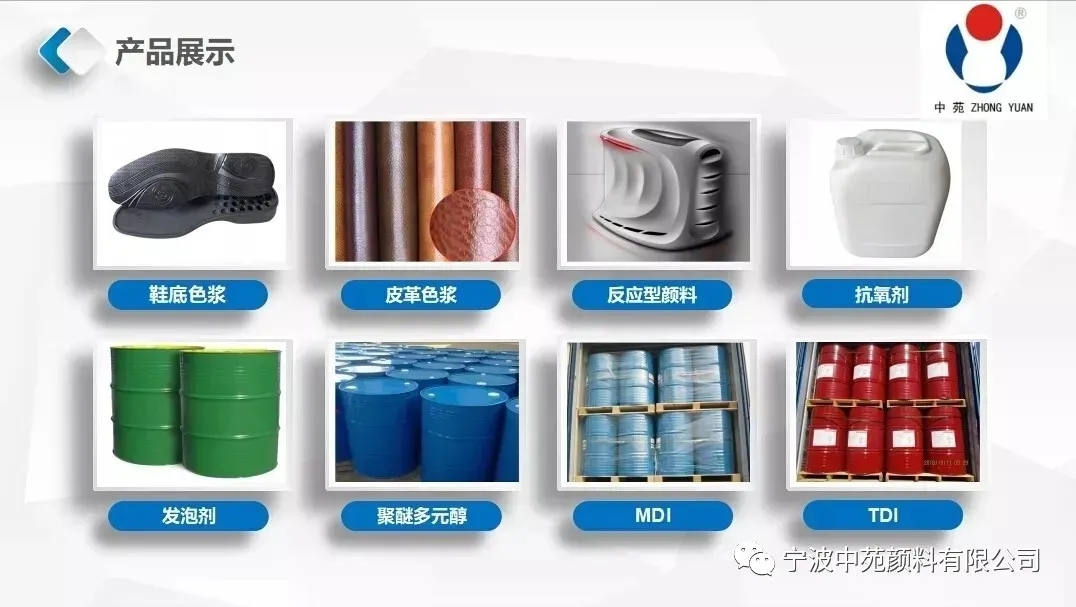
Color paste, as the main auxiliary agent used in polyurethane foaming, is widely used in various polyurethane materials. Our factory, as a professional polyurethane color paste manufacturer in East China, produces color pastes with high color density, good fluidity, large additions without affecting foaming, bright colors, and strong weather resistance.......

Abstract: The advantages of rigid polyurethane foam and their application in practical work are expounded, the foaming process and molding method of rigid polyurethane foam are discussed, and the influencing factors of rigid polyurethane foam in foam molding are analyzed in-depth ,for reference.
1 Overview
In recent decades, in all areas of production and life, the annual growth rate of rigid polyurethane foam production has been very rapid. There are a large number of gases and liquids that need to be transported, stored, and transported under conditions of thermal insulation and cold storage. There are many shortcomings for the thermal insulation and cold insulation of these containers, equipment, pipelines, and traditional thermal insulation and cold insulation materials, such as asbestos, slag wool, perlite, sawdust, asphalt, fiberglass, etc. The construction procedures of these thermal insulation materials are complicated and the operation is inconvenient , Some materials are still a great hazard to the health of construction workers. In addition, these thermal insulation materials have high thermal conductivity, poor thermal insulation effect, severe energy loss, and short service life. In contrast, polyurethane rigid foam has the lowest thermal conductivity, and can well abandon the shortcomings of traditional thermal insulation materials, especially in terms of thermal insulation performance of materials, which can not be compared with other thermal insulation materials. It is mainly used in the construction and central heating industries, followed by refrigeration equipment such as refrigerators and freezers, and thermal insulation materials in the transportation industry.
With the gradual maturity of rigid polyurethane foam production, the expansion of market supply, the continuous deepening of research work, the development of new varieties, new processes and new equipment, the rigid polyurethane foam has been fully developed. In terms of manufacturing technology of rigid polyurethane foam products, higher requirements are put forward. Large-scale foaming equipment is generally used for large-scale, continuous, automated, and serialization to improve labor productivity, reduce costs, and reduce raw material unit consumption. A computer is used to control various parameters such as material temperature, flow rate, and flow rate to adjust to produce better quality. Polyurethane foam.
2 Advantages of rigid polyurethane foam
1) Good thermal insulation effect. The use of polyurethane rigid foam and polyisocyanurate rigid foam not only makes the insulation layer thin and light, but also has excellent thermal insulation effect.
2) Polyurethane rigid foam and polyisocyanurate rigid foam have a high closed cell rate, and can produce a dense outer skin layer, which is not easy to penetrate water and has good waterproof effect.
3) Good thermal stability and wide operating temperature range. The new polyurethane rigid foam and polyisocyanurate rigid foam insulation layer can work for a long time under the condition of 150 ℃, and the service period can be as long as 25 years.
4) Good chemical resistance, not only heat and heat preservation, but also good corrosion resistance.
5) Large-scale mechanized production can be carried out in the factory, with high efficiency and good quality; the construction is simple and convenient, and the health of the construction personnel is not damaged, safe and reliable.
3 Rigid polyurethane foaming process and molding
There are three types of rigid polyurethane foam foaming: prepolymer method, semi-prepolymer method, and one-step method.
1) Prepolymer method: Usually, an equal part of polyether and isocyanate are mixed and reacted to form a low molecular polymer prepolymer. Then, water and the prepolymer are reacted under stirring to form a urea group to form a high polymer. Due to the generation of carbon dioxide in the reaction, the chain growth foam is formed to produce foam.
2) Prepolymer prepared by semi-prepolymer method: a part of polyether and excess isocyanate are mixed and reacted to form a low molecular weight polymer with a certain viscosity, and the excess part of polyether is mixed with water, catalyst and surfactant at high speed to mix evenly After the formation of rigid or semi-rigid foam.
3) One-step method: the polyether, isocyanate and other components are all mixed at the same time to obtain the foam plastic. The one-step manufacturing process is simple and easy to operate, can be used directly without processing, and can be carried out at room temperature. The miscibility of the raw materials is good, and the foamed products have excellent performance.
The foaming process of rigid polyurethane foam is usually mixed with polyether or polymer polyol, isocyanate, water, catalyst, surfactant, etc. in a proportioned formula to form a liquid raw material in the foaming equipment. It has a certain viscosity and is mixed at high speed. The post-reaction is mixed by a metering pump at a high speed in the mixing chamber, sprayed into the preparation of the mold, and cured at a certain temperature to form a polyurethane foam. At present, one-step methods are used in industrial manufacturing to prepare pre-polymers with different branch types.
The simplest foam molding method of rigid polyurethane foam is the manual foaming method. The raw materials are placed in a container in proportion, mixed at high speed and mixed evenly, and injected into the space filled with foam plastic. After the chemical reaction is cured, the polyurethane foam is formed. The raw material utilization rate is low, suitable for scientific research in the laboratory, temporary construction on site. However, in large-scale production, mechanical foaming is used, including: block foam continuous molding, pouring foaming, spray foaming and other processes. The most common molding methods are casting foam, spray foam, and continuous foam. The foam properties produced by different foaming processes are also very different, and the shape and appearance are also different.
4 Influence of rigid polyurethane foam molding
1) Raw materials: Polyether and polyester are used as components for foam molding. The ratio of polyether polyol and isocyanate is different, and flexible foam, semi-rigid foam and rigid foam can be prepared. The temperature of the raw material directly affects the accuracy of the metering ratio, as well as the viscosity of the material. Once the viscosity changes, the output accuracy of the metering pump changes, which seriously affects the quality of the product. The polyether polyol component is too large, the resulting foam is soft and poor in dimensional stability at high temperatures; the isocyanate component is too high, and the foam is hard and brittle.
2) Temperature: During the foam molding process, the temperature of the material and the ambient temperature directly affect the quality of the foam plastic products. Long-term storage and temperature changes are also detrimental to isocyanates. The presence of dimer in the isocyanate makes the isocyanate change turbidly and also interferes with the normal reaction. In production, when the temperature is low, the foaming reaction is slow and the foam curing time is long; when the temperature is high, the foaming reaction is fast and the foam curing time is short.
3) Injection temperature, speed and pressure: Before injection molding, high-pressure circulation should be carried out, so that the temperature of the material rises due to high-pressure movement, so the injection temperature is different from the storage temperature of the raw material. It depends on the cycle time and pressure, and the injection speed has a great influence on the mixing of raw materials. Generally, the injection speed is fast and the stamping is high, which can produce high-quality foam products.
4) Mold temperature: It is a key factor for foam molding, which can directly affect the milky whiteness, drawing, non-stickiness and curing speed of the foam, so it must be strictly controlled. Foam molding is a chemical reaction exothermic process. The released heat vaporizes the foaming agent and squeezes in the polyurethane-filled cavity to form a foam with irregular-sized cells. Mold temperature is a more important process parameter, which not only affects the speed of reaction heat removal, but also affects the molding time, which will adversely affect the density, surface thickness and dimensional stability. During the foaming process, the foaming agent reacts and releases heat, forming polymers that push, roll, and climb against each other in the filled cavity and contact the surface of the mold. The cells rupture and collapse to form a dense layer. When the mold temperature is high, an extremely thin surface layer is formed, which cannot meet the coloring requirements, and the surface of the workpiece is prone to produce defects; when the temperature is low, the foaming ratio is small, and the skin is too thick, which will reduce the thermal conductivity.
5) Curing time: The process of placing the foam plastic at a certain temperature after curing, the purpose is to allow the foaming reaction to proceed completely to obtain a good product. When injecting into the mold, the foam and the mold should be heated and stored in a higher temperature environment after the completion of the foaming reaction. The higher the temperature, the shorter the curing time. The temperature is low, the curing time is long, the aging is not sufficient, and the foam strength does not meet the required requirements. The variety of raw materials and the shape and size of the parts are different, and the required curing time and temperature are also different.
6) Mixing: Mixing efficiency is a key factor in foam molding. According to the characteristics of the raw materials, adjust the metering ratio and material temperature of the foaming equipment to achieve the purpose of full mixing. The mixing is uniform, the foam cells are fine and uniform; the mixing is not good, the cells are coarse and uneven, and even the chemical reaction is insufficient in the local area, which greatly affects the quality of the product.
7) During the foaming of the mold, due to the reaction of polyether and isocyanate to generate carbon dioxide gas, the polymer expands to generate a certain internal pressure. The mold restricts the development of the foam shape. It should have sufficient strength and smoothness of the inner surface to ensure that the foam is completely filled, and will not cause foam cracking and hollowing in the late stage of foaming, so that the foam is evenly and densely distributed in the mold. The injection port and exhaust port should also be opened at a reasonable position to avoid the occurrence of large local cells and shrinkage.
5 Conclusion
The rigid polyurethane foam industry has developed rapidly in different industries. The quality requirements of rigid polyurethane foam are getting higher and higher, so for different raw materials, by changing the formula, improving the accuracy of the foaming equipment and the foaming molding process to prepare a variety of different density, different properties to meet different applications of rigid polyurethane foam plastic products.
![]()
![]()
We respect originality. The text picture material, the copyright belongs to the original author. Some articles could not be contacted with the original author due to various reasons. If the copyright issue is involved, please contact the original author to deal with it immediately.

Factory address: Longzhen Avenue, Longshan Industrial Zone, Cixi, Ningbo
Marketing Center: 1308 Yaojiang Xindu, Hongtang Street, Jiangbei, Ningbo
Phone: +860574-86501282-0
83096225 83096226
Fax: +860574-86501283
Website: http://zy-pigment.en.alibaba.com/